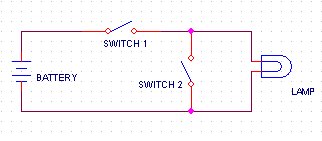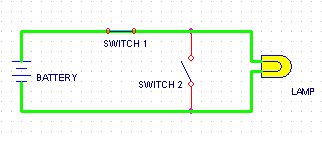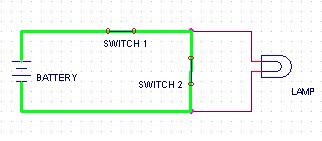Circuit Basics
 An 'open circuit'
An 'open circuit'
The simple circuit shown above is typical of what we may see in a flashlight. Electrical current wants to flow from one side of the battery to the other. If a light bulb is in the path that the electricity wants to take it will light up when the electrical current flows through it. When Switch 1 is open as shown. The light bulb does not light because the electrical path through the light bulb to the other side of the battery is broken or 'opened up'. If current cannot flow around the circuit it is said to be 'open'. It may be desirable to open a circuit, like ours, to turn off the light coming from a bulb. Sometimes though, a circuit may become open when we don't want it to, Like if a wire breaks or the bulb burns out.
 A 'closed circuit'
A 'closed circuit'
A circuit is closed when there is a complete path for the electrical current to follow from one side of the battery to the other. In our circuit the electrical current flows from one terminal of the battery through the closed switch to the light bulb. The current flowing through the bulb causes it to glow. Then the current continues from the bulb back to the other terminal on the battery
 A 'short circuit'
A 'short circuit'
A circuit becomes 'shorted' if the electrical current takes a short cut from one battery terminal to another and does not go to the light bulb. In the circuit above we closed switch2 so electrical current had a short cut back to the battery. Since the current did not make it to the light bulb it did not glow. A short circuit is a bad thing because the electrical current is not going to where it is supposed to. When the light bulb is in the electrical current's path the electrical current is kept low by the bulb's 'resistance'. But if the electrical current found an easy short cut back to the battery a lot of current may flow causing the wires to get very hot and start a fire.